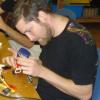Search the Community
Showing results for tags 'pic'.
-
After I solderd all of the components I got this reslut... No Device id
-
Hello all, I have recently completed a Sammich that has been sitting on a friends shelf for the last 4 years! I will explain what has happened so far to try and give a clear picture. The build went really well apart from a lifted pad which was repaired (this only affected the low power LCD backlight) and is now working. Everything electrical checks out, all test points are clear and there are no shorts, the correct jumpers are set for the 8508 SID's, the voltage jumpers are correct also. Basically the Sammich turns on and the LCD shows some black squares, then tells me: MIOS v1.9g ©2009 T Klose, and then goes on to say READY. I have an M-Audio 2x2 midisport usb interface, I have downloaded the latest MIOS Studio software (PC and Mac), and the latest setup_sammich_sid.hex, and the mios_v1_9g_pic18f4685.hex My problem is that no matter what i do, it doesn't seem to want to let me upload the hex file to the PIC/Sammich. when I first power on the sammich, if i press query in the mios studio immediately, i get the screen telling me its connected to the core and ready, and then i browse for the setup_sammich_sid.hex and hit start, and then it tells me it can't contact the core and to reboot the sammich, which i do, it tries to do it then it says it can't it and gives me an error saying: Upload aborted due to error #12: MIDI IN Frame ErrorNo response from core after 16 retries! It only ever seems to give me the connected to core message immediately after I power it on, and press query, and then only very briefly, from what i understand, it is supposed to keep polling every few seconds for an upload if it doesn't have mios/hex burnt in. I have tried doing this under windows 7 64bit, and OS X 10.10, using the same M-Audio 2x2 ( isee from the white/blacklist that this particular device may not work under OS X, hence why I'm trying under windows 7. I have looked at the troubleshooting guide, and done the midi loopback tests from the PC and the sammich, and the check out fine. I think i either have a duff midi interface, or something else is wrong. I will post some screenshots incase anyone else can help by looking at them, any help is greatly appreciated. [EDIT] I have now tried to upload the file from another 2 different types of midi interface on the Mac, but still have the same error in mios studio. [EDIT] I have just purchased a Neusonik uMIDI/O22 to test with, once it arrives i will give it a go and see if it makes any difference.
-
The Juno-106 sure has had its share of problems. The voice chips started to fail way back in the 1980s. By the last 1990s / early 2000s, another component started to fail: It is the HPF slider. On the front panel, all of the sliders are 50 K pots, except for the HPF slider, which is a 4-position slide switch. They have all either oxidized or deteriorated internally, and so they're all failing! Technology Transplant has effectively recreated the slide pots, but no switch is available. Here is my idea: The pot form factor is VERY similar to the switch. In fact, it would be pretty easy for an experienced technician to modify the board by snipping the traces from the 4-position switch - then, you could solder a slide pot into its place. Of course, since we cut all the traces, it won't be connected to anything. Now, we'll take some wire and solder the top and bottom pins of the pot to 0V and +5V, just like the rest of the pots. Then we'll create a little circuit that reads the value of the pot, and outputs the value by setting any of 3 pins high. Position 1 would be from 0% to 24% of 5V. For this position, no pins would be high. Position 2 would be from 25% to 49% of 5V. For this position, the circuit would set output pin 1 high. Position 3 would be from 50% to 74% of 5V. For this position, the circuit would set output pin 2 high. Position 4 would be from 75% to 100% of 5V. For this position, the circuit would set output pin 3 high. The output pins would be connected to a CMOS CD4016 bilateral switch, from which 3 switches would be connected to the Juno's panel board. The only caveat (and it is a small one) would be that the slider wouldn't have that nice "click" into each of the 4 positions. I thought of 3 different ways this could be done: With discrete voltage divider circuitry for each output. Unfortunately this would take a lot of work to get the component values perfect, and you wouldn't want the possibility of gaps between the values (like at 49%, maybe you'd see no output, or maybe you'd see pin 1+2 high at the same time. Bad. LED bar graph driver like LM3916. Set the IC to "dot" mode. With the correct reference voltage, you could probably set this IC to output in 4 discrete, evenly-spaced steps from 0-5V. These outputs would be suitable to drive a CD4016 quad bilateral switch. I don't know, I've never tried one. PIC microcontroller. I just don't have the experience to program one of these from scratch. Even though I don't need the power of MIOS, it would probably be easier for me to use a MIOS-programmed PIC, because I could then modify an existing MIDIbox app to achieve this function in a quick-and-dirty fashion. The PIC should be able to draw power from the Juno's regulated 5V, and it wouldn't need MIDI i/o, so I could probably just build it on a small piece of perfboard instead of a Core PCB. What do you think? If you wanted to make a simple circuit to replace a 4-position switch with a slide pot, which method would you use? Or would you use something else (Arduino? Other?) If you like the MIDIbox PIC idea, what software would you receommend I start with? LM3916-datasheet.pdf
-
Hello, I've almost finished a guitar fx looper (which would need a major wiki update...), and i'm wondering if i could add a tuner to this box. As i'm not using any AIN, i have all the analog pins free to use. I think that the 10bits conversion is enough to have the guitar signal. I've found this in the forum but this is standalone project : The code for the fx switcher is pretty small, and written in C. So i guess there is room for the tuner code. Is there any code block known that i could use ? thanks


